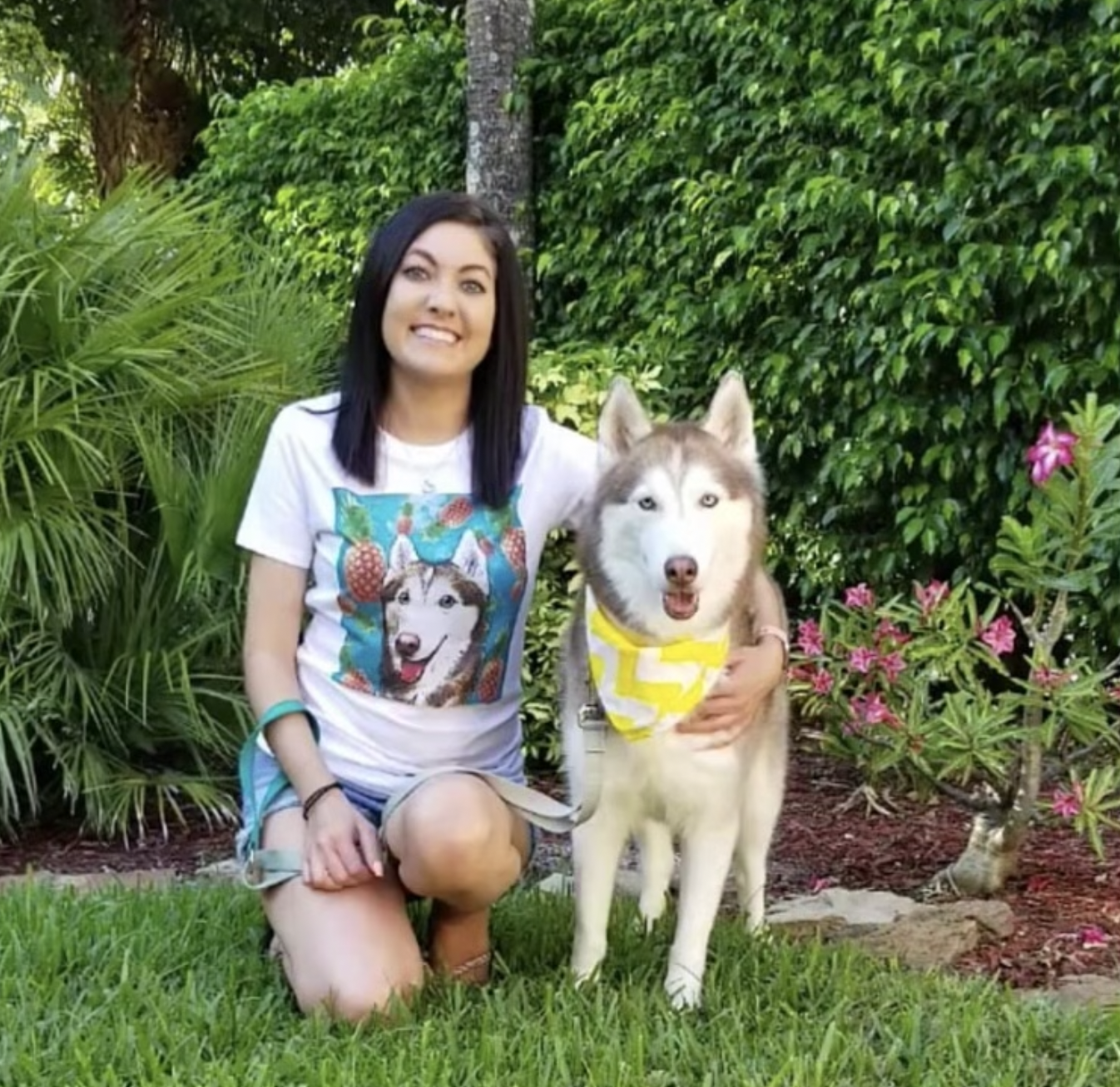Welcome to your puppy’s awkward and ornery adolescent months! In this third edition of our Puppy Survival Guide series for whippersnappers aged 5–6 months, we continue to break down the most important steps and need-to-knows for their health and wellness, training, behavior, nutrition, safety, and physical development—along with extra tips for dealing with teenage attitude.
Cheat Sheet Checklist For 5–6 Month Old Puppies
This essential task checklist rounds up key points from the article below.
| Essential Task Checklist For Puppies 5–6 Months Old |
|---|
| Month 5: ☐ Give monthly flea/tick/heartworm meds. ☐ Keep an eye out for females experiencing first heat cycle as early as month 5 (keep away from intact males). ☐ Consider purchasing doggie diapers for females in heat. ☐ Keep intact males away from females until neutered. ☐ Explore new places, meet new dogs in controlled situations. ☐ Continue potty training, crate training, and loose-leash walking. ☐ Continue practicing basic commands (sit, lie down, come, stay, etc). ☐ Start advanced commands by adding distraction or difficulty to basic commands (i.e. ask them to hold “stay” longer). ☐ Encourage play in the yard and light walks on a leash. ☐ Don’t force exercise (like running) until bones are fully grown at 12–18 months (too much/intense exercise can cause joint issues). ☐ Consider purchasing: GPS collar, reflective collar for night walks, a life vest if taking puppy swimming or near water. Month 6: ☐ Schedule 6-month vet visit. -Vet checks for retained puppy teeth -Discuss spay/neuter options and timing -Discuss gastropexy for large and giant breeds to avoid canine bloat (can be done during spay/neuter) -Microchipping ☐ Puppy hits adolescence. Go back to basic commands and more structure if they begin testing boundaries. ☐ Seek help from trainer if teenage stubbornness gets out of hand. ☐ Decrease meals from 3x daily to 2x daily for medium and large breed dogs (small breeds should have reduced meals to 2x/daily at 4 months) ☐ Consider purchasing pet insurance early to avoid pre-existing condition exemptions later. ☐ Give monthly flea/tick/heartworm meds. |
What Should You Already Be Doing Before Your Puppy Hits 5 Months?
If you missed the first two chapters of our Puppy Survival series, we suggest checking out Weeks 8–12 and Months 3–4 for previous cheat sheets. If you’re thinking, “Nah, ain’t nobody got time for that,” then here’s a quick recap of essential puppy tasks covered in those articles. These tasks should be started or completed by the time your puppy hits 5 months old:
- Fully vaccinated with core vaccines (DA2PP/DAP + rabies) and dewormed.
- Lost all their puppy teeth.
- Started puppy classes for socialization.
- Have a regular tooth-brushing and nail clipping routine.
- Well-socialized with introductions to at least 90 different different new, fun experiences (new people, places, things, and objects).
- Puppy-proof your home and vehicle—including buying a car seat or safety harness.
- Making progress with potty training, crate training, and learning not to bite/be mouthy.
- Understand basic commands (sit, down) and recognize their name.
- Working on “come,” “stay,” and “drop it”—although these may not be perfected.
- Working on manners (i.e. no biting, no jumping on people, no begging, walking nicely on leash).
- Giving monthly flea/tick/heartworm treatment.
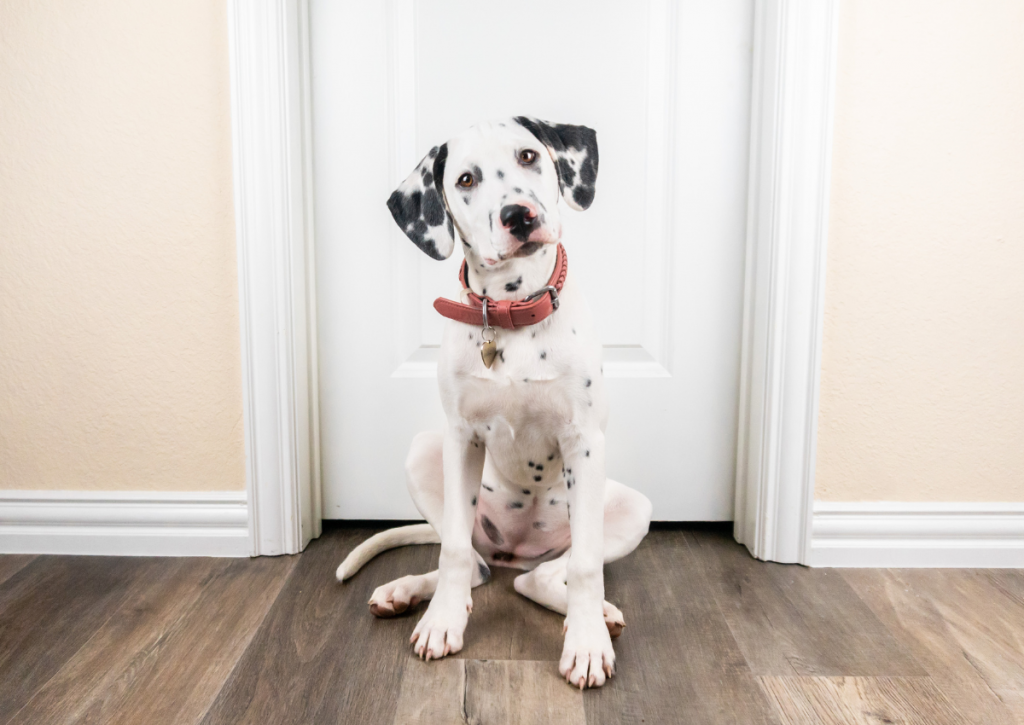

Physical Growth & Development
This section covers all the physical growth changes you can expect during months 5 and 6, as your puppy transforms from their “butterball” stage to their “lanky-long-legs” stage.
Physical Appearance & Changes
- Females may begin first heat cycle: As early as 5 months old1
- Adult canine, premolar, and molar eruption: 5–6 months old2
- May experience first “coat blow” (shedding puppy coat): 5–6 months
- All adult teeth should have erupted or are visibly coming in above gum line: 6 months old2
- Puppy can hold bladder and bowels for 5–7 hours: 6 months old3
- House-training usually complete: 6 months2
- Should have visible waistline to help determine ideal body weight: 6 months
- Larger dogs enter their lanky-legged, awkward teenage months: 6 months
Puppy Growth Chart2,4
| Dog Size | Weight | Rapid Growth Period | Timescale To Fully Grown | Total Lifespan |
|---|---|---|---|---|
| Toy (Extra Small) | Less than 8 lbs | Birth–11 weeks | 6–12 months | Approx 15+ years |
| Small | 9–22 lbs | Birth–4 weeks | 8–12 months | 14–16 years |
| Medium | 23–55 lbs | Birth–16 weeks | 8–18 months | 10–12 years |
| Large | 56–99 lbs | Birth–18 weeks | 11–18 months | 9–12 years |
| Giant | Over 100 lbs | Birth–20 weeks | 12–24 months | 7–9 years |
Adult Teeth
By now, your puppy should be past their “tooth fairy” stage and have lost all of their baby teeth (they should also have a hefty stockpile of treats left under their pillow by the tooth fairy). By the end of month 6, all your puppy’s adult teeth should either be completely erupted (visible above the gum line) or at least partially erupted2.
Eruption Schedule Of Puppies’ Permanent Adult Teeth5
| Type Of Permanent Teeth | Age (In Months) When Teeth Come In |
|---|---|
| Incisors (stubby front teeth) | 3–4 |
| Canines (pointy vampire-looking teeth) | 4–6 |
| Premolars (teeth behind canines used for chewing) | 4–6 |
| Molars (teeth all the way in the back) | 5–7 |
Growing Bones
At 5–6 months old, your puppy’s bones are still growing, and their growth plates are not yet closed—meaning their bones are not completely hardened yet4. At this age, forced exercise (like running or jumping) and rough play with older dogs can cause damage to their joints later in life4.
It’s best to keep play and exercise restricted to the yard or small areas, keep walks short and leisurely, and supervise play with other dogs until your puppy’s growth plates have closed around 12–18 months. Your vet can help you determine when your puppy is ready for more exercise.
Puppy Puberty
Both male and female puppies typically begin reaching sexual maturity around 6 months old, however, some pups reach sexual maturity as early as 5 months1. To be clear, this means that females are now capable of becoming pregnant, and males are capable of impregnating females once they reach sexual maturity.
It’s important to note that allowing dogs to become pregnant at this young age is not only unethical but dangerous to both the mother and potential puppies. At only 5–6 months of age, a puppy’s body is not yet fully developed to safely carry puppies to term without risk. If you think your puppy wants to experience motherhood before she’s spayed, she DOES 👏 NOT 👏 CARE 👏 ! Don’t selfishly project your wishes upon her.
Take Steps To Avoid Accidental Pregnancy
Around 5 months old, it’s important to keep an eye out for signs that your puppy has reached sexual maturity, and take precautions to avoid accidental pregnancies.
- Learn how to recognize when a dog reaches sexual maturity (a.k.a. females in heat, males all up in females’ business). *See table below.
- When your female puppy is in heat (this may not be visibly apparent early in their heat cycle) keep her away from intact males.
- Keep your male puppy away from any intact female dogs who are in heat.
- Avoid taking your puppy to dog parks, doggie daycare, or letting them off leash where there may be intact dogs.
- Separate your puppy from any intact dogs in your household when a female is in heat.
- Put a doggie diaper on female dogs during heat cycle.
- If you think your puppy may have mated with another dog by accident, contact your veterinarian immediately to discuss your options.
| Signs Of Female Sexual Maturity | Signs of Male Sexual Maturity |
|---|---|
| Bloody discharge/drops of blood around house from first heat cycle/estrus cycle (a.k.a. “doggie periods”) | Interest in females in heat |
| Swelling and redness around vulva (a.k.a. your pup’s girly bits) | Short attention span |
| Licking and chewing near vulva | Chewing/biting |
| “Flagging” and “rear showing” (Females approaching males to say, “hey! look at my bum!”) | Hyperactive |
| Roaming | Roaming |
| Mounting/humping (Yup, the girls do it too!) | Mounting/humping |
| Aggression/mood swings, especially with other dogs | Aggression/biting |
| Territorial marking or asking for excessive potty breaks outside (driven by instinct to roam to find a mate) | Marking territory |
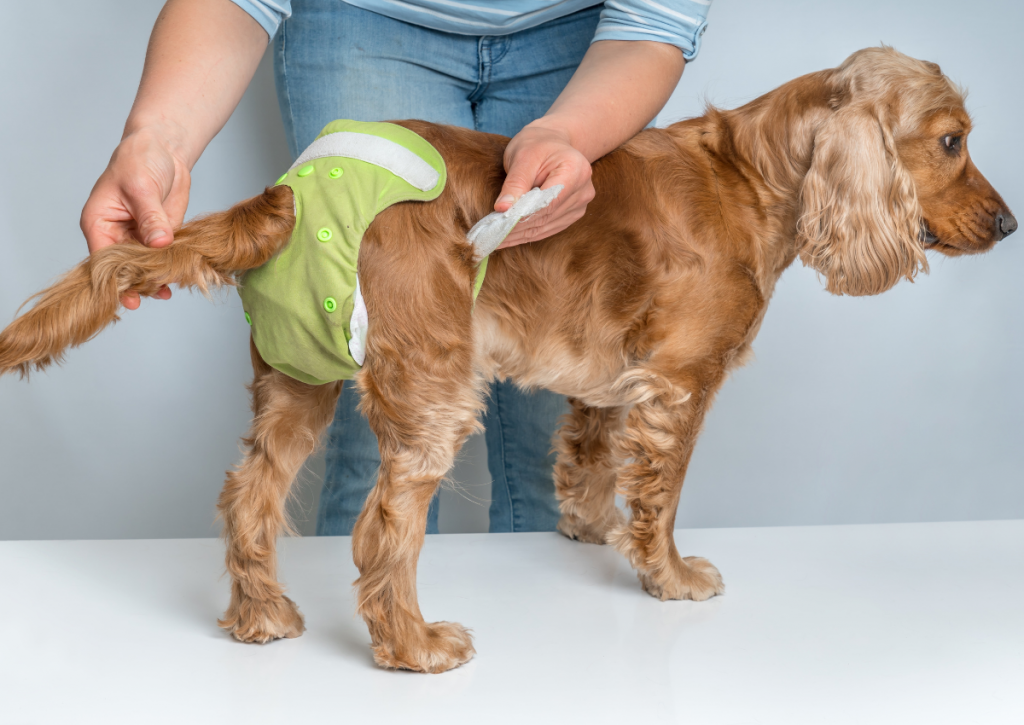

Behavior & Personality
By now, your puppy should be well-socialized and have had plenty of experiences meeting all kinds of new people, sniffing new butts, exploring new places, and interacting with bunches of new objects. It’s perfectly normal if they still think the vacuum looks “sus” and the mailman looks sketchy AF—as long as you’re working with them to conquer any fears!
Fear Impact Period
Speaking of sketchy vacuums, it’s important to remember during this whole first year—and continuing from the last few months— that your puppy is still in a stage where they’re more easily spooked (the “fear impact” period) by just about anything new or unusual2. Always take baby steps with new introductions and give lots of treats to reassure them.
Puppy Adolescence
Remember your angsty and rebellious teenage years? Your hormones started raging. Independence became a top priority. And, more than likely, you were a total jerk face to your parents on occasion. Well, around the 6 month mark your puppy is going to hit a similar teenage stage—complete with raging hormones, puppy puberty, and plenty of attitude!
What Should I Expect During Puppy Adolescence?
During this time, your puppy will likely gain confidence, begin exploring on their own, and seek more independence2. With this newfound confidence, they may start testing boundaries (breaking rules) and ignoring commands that they already learned. It’s important to understand that this is just a phase, and it will pass!
This is not them purposefully being a jerk! They are not intentionally rebelling against you or disrespecting you. These behaviors come from a combination of changing hormones, growing confidence, and the instinct to become a strong, independent pup who don’t need no human2! It’s your job to help them learn how to develop these qualities while still following house rules.
| What You Think Your Puppy’s Intentions Are | What Your Puppy’s Intentions Probably Are |
|---|---|
| Intentionally ignoring commands | Learning self-reliance |
| Breaking rules | Trying to figure out how to be independent |
| Purposefully disrespecting you | Looking for guidance as they gain new confidence |
| Being rebellious | Trying to take care of themselves without help |
| Being “bad” on purpose | Navigating how to balance independence and rules |
How Do I Deal With My Adolescent Puppy Pushing Boundaries?
Stay Calm: Do not yell. Do not punish as a reflexive reaction. Anger, yelling, and hitting are only going to teach your puppy that humans are something to be afraid of. Their brain is going to focus more on your scary, angry emotion than the lesson you’re trying to teach them. That’s the recipe for fearful, skittish, and emotionally damaged adult dogs. Instead, stay calm. Take a break from training for a few hours. Take a moment away from the situation to calm down before returning.
Go Back To Basics: This is not a step backward, but rather a way to reinforce structure and routine for your teenage pup. Focus on basic commands, positive reinforcement, and treats for good behavior. Most importantly, don’t let them ignore you. For instance, if your pup won’t come when called, approach them with a neutral attitude, and put their leash on them to calmly direct them where you want them to go. Then, reward with a treat. If they’re being stubborn about listening to commands, remind them how to complete the command, make sure they actually complete it (even if it’s less graceful than usual), and give them a treat before moving on.
Stay Consistent: By staying firm, fair, and predictable you will help your puppy leave this teenage attitude behind as they grow into a well-behaved adult. Don’t let them ignore you. Stick to your guns, but be gentle and understanding. This is just a phase of learning.
Talk To A Trainer: Puppies can be difficult. Trainers are there to help! They can give you the confidence and guidance to help you raise a stubborn pup. Sometimes, pup parents at their wit’s end end up choosing to rehoming their puppy or surrender them to a shelter—scared, alone, and confused about what they did wrong. Reaching out to a trainer can help you turn things around, so it never needs reach this point.
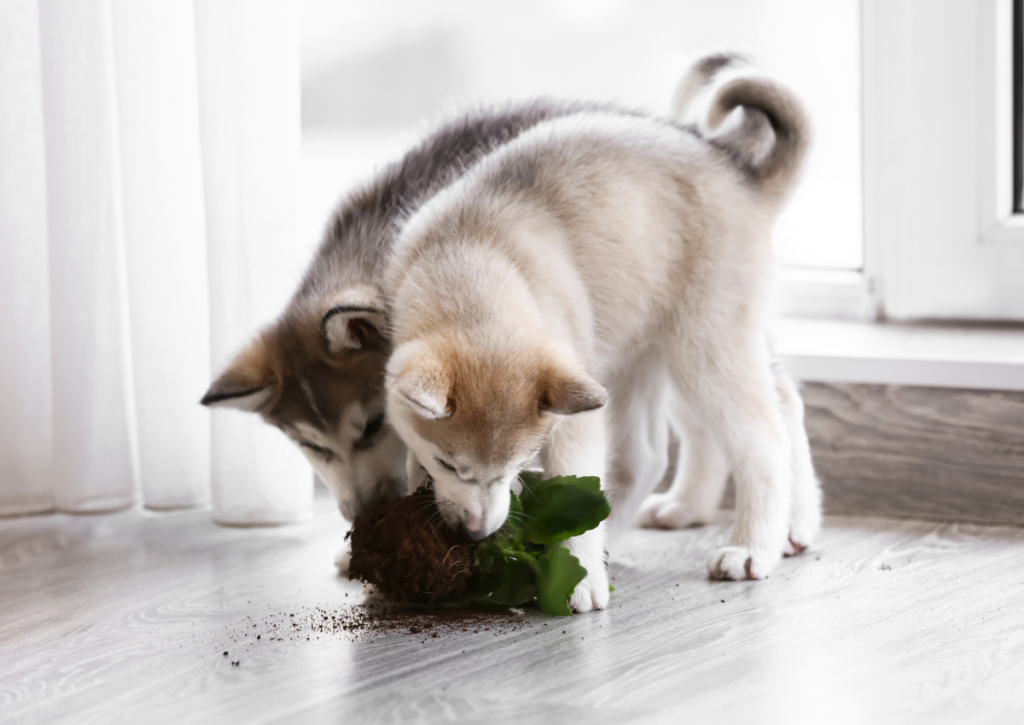

Health & Wellness
By now your puppy should be dewormed, started on flea/tick and heartworm prevention, completed their full set of core puppy vaccines, and had a thorough physical exam. By month 5, you get to relax a bit and take a break from vet visits. During month 6, you’ll want to schedule a vet appointment to discuss important topics like:
- Spay/neuter options and timing.
- Gastropexy surgery for large and giant breed dogs.
- Microchipping.
- Dental check-up looking for abnormalities.
Spay/Neuter
Spaying or neutering your pup is a responsible choice to help control the serious problem of pet overpopulation. Over 3 million dogs enter U.S. shelters each year, which leads to overcrowding. Sadly, many of these dogs will end up euthanized for no reason other than to create additional space.
Related: Spaying Or Neutering Your Dog: Benefits, Risks, & More
When Should You Spay Or Neuter Your Dog?
Although the best time to spay and neuter dogs is still debated among veterinarians, generally dogs should be spayed no earlier than 6 months old2. It’s best to discuss spay/neuter options with your vet at your puppy’s 6-month check-up, and allow them to guide you. As important as it is to avoid unwanted pregnancies, vets may also want to wait a few extra months before spaying or neutering—taking into consideration how the timing will affect your pup’s growth, hormones, cancer prevention, and behavior.
Advantages Of Spaying Or Neutering Your Dog:
- Avoid accidental pregnancies, and help control pet overpopulation.
- Neutered males are less likely to roam, bite, show aggression, or mark territory in the house2.
- Avoid the messiness and doggie diapers involved with female heat cycles2.
- Avoid physical issues such as pyometra (life-threatening uterine infection), mammary cancer, prostate infections, prostate cancer, and perineal hernia (male)2.
- Many pet hotels, dog parks, and doggie day camps require dogs to be spayed or neutered in order to participate in group play.
- Your house guests don’t have to endure your dog humping their leg, or witness your dog spread-eagle on the couch, airing out their goods.
Disadvantages Of Spaying Or Neutering Your Dog:
- May risk orthopedic issues later in life if spayed or neutered too early2.
- Research is still needed to determine if there are increased risks for other cancers and health issues2.
Gastric Dilatation-Volvulus (GDV) & Gastropexy
GDV (canine bloat) is mostly an issue with large and giant breed dogs2. This is a life-threatening condition where a dog’s stomach becomes overstretched and can twist due to excess air and pressure build-up from gas. This condition is deadly if not corrected with emergency surgery2.
How Can I Prevent My Dog From Experiencing GDV/Canine Bloat?
- If you have a large or giant breed puppy, ask your vet about gastropexy preventative surgery for your puppy.
- Use a slow feeder bowl to prevent your puppy from eating too quickly, as they tend to swallow more air2.
- Increase in age and genetic factors seem to play a role in probability of experiencing GDV2.
- Although it was once suggested to restrict exercise/play before and after mealtimes, there is little evidence proving this is effective2.
Gastropexy Surgery
A gastropexy is a preventative surgery and life-long solution to avoid GDV, in which your puppy’s stomach is tethered to the wall of their body to keep it from flipping2. This is the most effective method for preventing bloat, and is often suggested for large or giant breed dogs who are more commonly affected by GDV.
Microchipping
Microchips contain ID information about your dog, including their name, address, and human’s phone number. Newer ones even work as a thermometer, so that the vet can just scan your dog at vet visits, instead of sticking a thermometer up their bum!
When Should My Dog Be Microchipped?
Puppies can be microchipped practically any time after 8 weeks old. The microchips are about the size of a grain of rice, and need to be injected underneath your dog’s skin. Although it’s a fairly low-pain procedure, some puppy parents choose to wait and have the microchip placed while their puppy is under anesthesia for spay or neuter procedures.
What Is The Benefit Of Microchipping My Dog?
Note: you cannot physically trace your dog’s location through a microchip, but there are plenty of benefits:
- It’s a simple, low-pain procedure.
- Inexpensive—some clinics offer microchipping for as low as $15.
- Dog always has their ID info on them.
- Helps return dogs to their people even they’re not wearing their collar + tags.
- Certain microchips come with memberships that help inform neighbors your pet is missing, give you access to animal poison control hotlines, and more.
Dental Check
During your puppy’s 6-month vet visit, your vet should thoroughly check for dental abnormalities common at this age:
- Unerupted Teeth: Teeth below the gum line (seen by x-ray) that have not erupted (come in) by month 6. Left untreated, these can form cysts or cause bone destruction5.
- Malocclusion: Teeth that are not aligned properly—commonly overbites and underbites. Malocclusions often require doggie orthodontic treatment or tooth extraction to avoid further dental issues5.
- Dental Crowding Or Extra Teeth: Teeth that are crowded too tightly together tend to easily trap food and bacteria, leading to periodontal disease. Common in small breed dogs5.
- Deformed Teeth: There are many types of tooth deformities, including a condition where a tooth folds in on itself, and many others that may require x-rays to diagnose5.
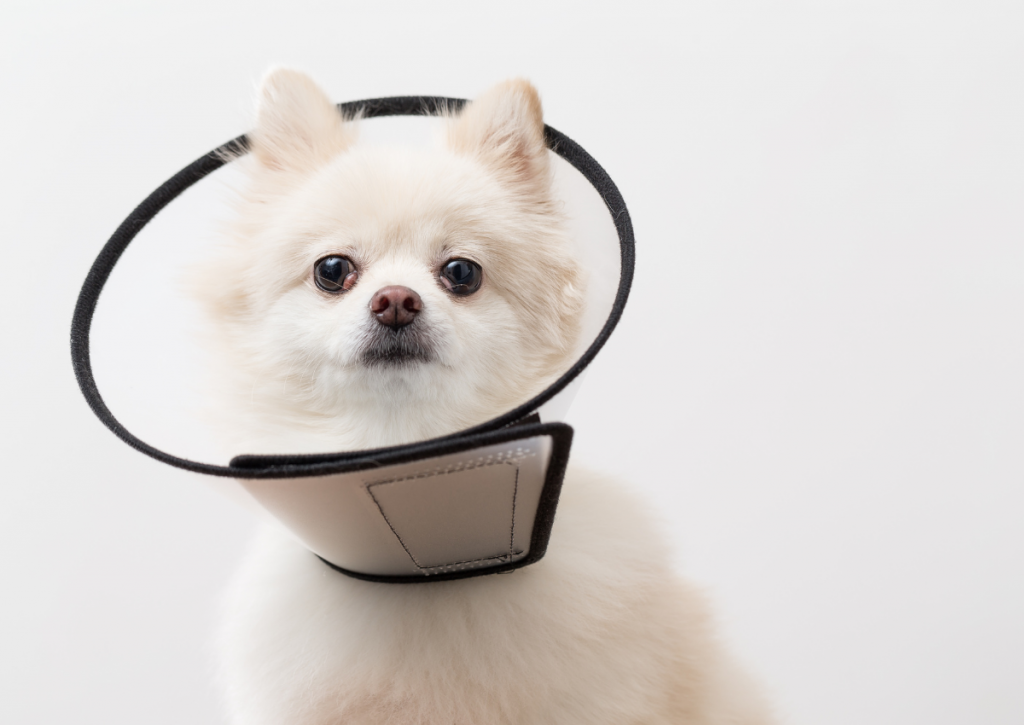

Nutrition & Exercise
As your puppy gets older, they will begin falling into a more manageable eat, sleep, poop routine, requiring fewer daily mealtimes, potty breaks, and hours of sleep, and tolerating an increased amount of gentle exercise and play.
| 5 Months Old | 6 Months Old | |
|---|---|---|
| Eat | Small Breeds: Feed 2x daily Medium Breeds: Feed 3x daily Large/Giant Breeds: Feed 3x daily2 | Small Breeds: Feed 2x daily Medium Breeds: Feed 2x daily Large/Giant Breeds: Feed 2x daily2 |
| Sleep | 15–20 hours per day | 13–18 hours per day |
| Potty | 4–6 potty breaks per day3 | 4–6 potty breaks per day3 |
| Play | About 25 minutes of leisurely exercise | About 30 minutes of leisurely exercise |
Always do you own research when picking the perfect food for your pup, but if you need a place to start, try BARK Food for puppies! Get 25% off and forever free shipping with code 25FOOD.
Ideal Weight
By 6 months old, you should finally start to see a distinguished waistline to help you better judge your puppy’s ideal weight. You’re aiming for the “hourglass” figure with a narrow waist. If you’re still unsure if your pup is too thin, too chonky, or just right, your vet can help you assess their proper weight.
Restricted Play & Exercise
While your puppy’s bones are still growing, it’s important to avoid any forced exercise (i.e. running, jumping off furniture, rough play) until they’re 12–18 months old, depending on their breed size4. At 5–6 months old, you’ll want to restrict play to the yard and going for leisurely walks on a leash.
The common rule of thumb is to add 5 minutes of exercise each month as your puppy grows—for instance, at 5 months your puppy could exercise for 25 minutes, and at 6 months for 30 minutes4. However, exercise requirements and limitations differ according to breed, so never hesitate to ask your vet for clarification.
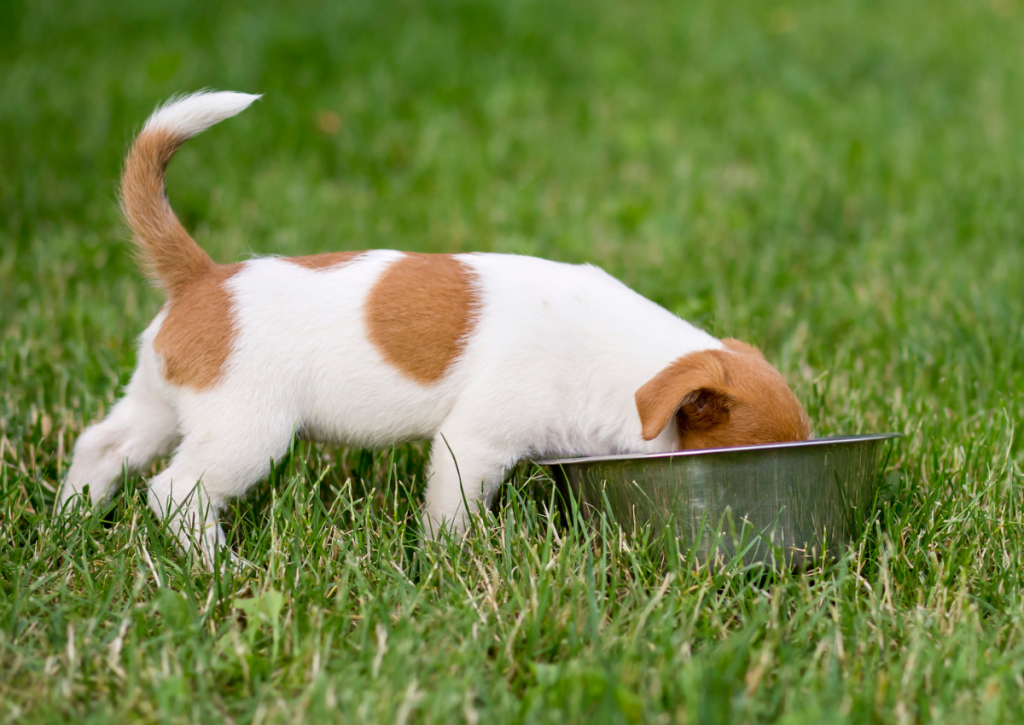

Training
By the end of month 5 your puppy should be fully potty trained, be accustomed to using a crate, know their name, and understand basic commands like “sit” and “lie down” without trouble. They should be getting the hang of “stay/wait” “come/here” “leave it/drop it,” walking nicely on a leash, and maybe even shaking paws and fetching.
Keep Practicing Basic Commands
Remember: If you don’t use it, you lose it! This also applies to puppies learning their basic commands. Once they know the basics, keep practicing for a few minutes each day so they stay sharp (and so you can show off their sweet tricks to friends).
Begin Advanced Commands
Your puppy should be ready to take things up a notch. Try not to throw too much at them too fast, but introduce new commands or difficulty levels once your puppy has shown they’re getting the hang of the basics.
- Practice heeling on walks around the neighborhood.
- Hold commands longer (i.e. holding “stay” and “leave it” longer).
- Practice in different locations with distractions.
- Use a “place”/”bed”/”crate” command to tell your dog to go to a specific place.
- Try a new, fun command like “shake/paw” or “roll over.”
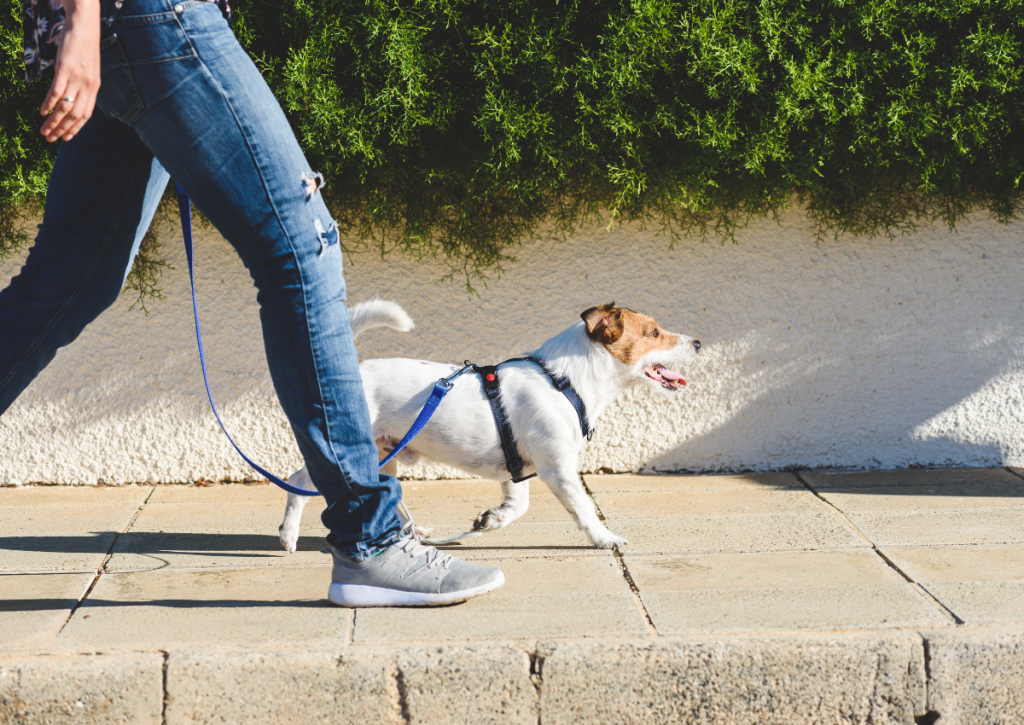

Puppy Safety
Your puppy is going through a period of increased confidence and independence-seeking, but sometimes they bite off more than they can chew. Be prepared for you puppy to go looking for trouble and take steps to keep them safe:
- Reinforce Fences: If you have a yard with a fence, make sure to patch holes and fill in gaps. Your puppy’s curiosity is kicking into high gear, and they may turn into escape artists.
- Close Doors Behind You: It only takes one mistake to learn this lesson the hard way. Adventurous puppies may try to slip past you as you enter or leave the house.
- Consider A GPS Collar: At 5 or 6 months old, your puppy may be getting faster, sneakier, and eager to explore. GPS tags and collars connect to a phone app, so you can trace their location if they manage to make a break for it.
- Get A Life Vest: If you live by a lake, ocean, or have a pool and have started introducing your puppy to water, consider buying a life vest. Yes, your dog can probably swim, but heavy currents, rip tides, or deep water can be too much for even the best doggie paddlers—especially if they unexpectedly jump from a boat, kayak, or paddle board. Even laps around the pool can get tiring, and it’s always better to play it safe.
- Look Into Reflective Gear Or Light-Up Night Gear: Do you and your puppy like to take night walkies? Drivers and bikers are often on the lookout for pedestrians at night, but not always those with 4 legs. It’s a good idea to get your puppy a reflective collar or harness with lights so they are easily visible.
Puppy Products To Consider
Need an essential product refresher? Check here!
Additional Products/Memberships For Your 5–6 Month Old Puppy
- Doggie diapers for females in heat (prior to spay)
- Pet insurance
- Microchip
- GPS collar or GPS tag
- Puppy life vest
- Reflective gear or LED lights for night walks
- Puppy training classes
- Training treats
- You can never have too many toys!
- Don’t let your dog become part of the 80% with dental disease by age 3. Take care of their teeth with an easy toothbrush-less dental kit.
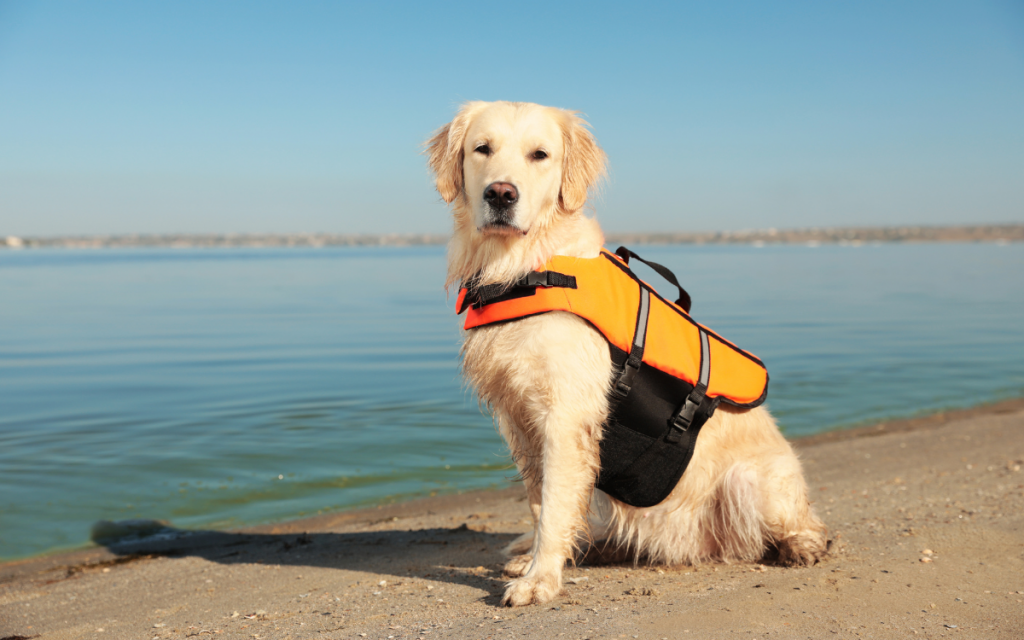

Emergency Resources
ASPCA Animal Poison Control
If your puppy eats something they shouldn’t, call the animal control poison center at (888) 426-4435.
Emergency Vets
If your puppy has an emergency when their regular vet is closed, you may need to find a 24/7 emergency vet near you. Emergency Vets USA enables you to search for an emergency vet by state or call (855)-778-6815.
Lost Pet
National hotline for reporting lost pets 1 (800) 486-2631.
Dog CPR How-To
Dog CPR Quick Guide
Dog CPR Training Video
Choking Dog/Dog Heimlich Maneuver
Dog Heimlich Maneuver Training Video
Sources
1“When Should I Spay or Neuter My Pet?” AAHA (American Animal Hospital Association), https://www.aaha.org/your-pet/pet-owner-education/ask-aaha/spay-or-neuter/.
2Hennet, Margo. “Puppy Survival Guide.” 2 Mar. 2022.
3Youngerman, Claire. “House-Training Your Puppy.” Animal Health Topics , UC Davis | School of Veterinary Medicine, 24 Nov. 2021, https://healthtopics.vetmed.ucdavis.edu/health-topics/canine/house-training-your-puppy.
4Lewis, Georgia. “Musculoskeletal Development of the Puppy Birth to Twelve Months.” Research Gate, Hartpury University: Animal Therapy Magazine: Issue 15, 2019, https://www.researchgate.net/profile/Georgia-Lewis/publication/333118590_Musculoskeletal_Development_of_the_Puppy_Birth_to_Twelve_Months/links/5cdc8200299bf14d959c443d/Musculoskeletal-Development-of-the-Puppy-Birth-to-Twelve-Months.pdf.
5Hale, Fraser A. “Juvenile Veterinary Dentistry.” Veterinary Clinics of North America: Small Animal Practice , 2005, https://www.vetsmall.theclinics.com/article/S0195-5616(05)00023-9/fulltext.
6Bukowski, John A., and Susan Aiello. “Breeding and Reproduction of Dogs .” Merck Veterinary Manual, Merck Veterinary Manual, 7 July 2022, https://www.merckvetmanual.com/dog-owners/routine-care-and-breeding-of-dogs/breeding-and-reproduction-of-dogs.

